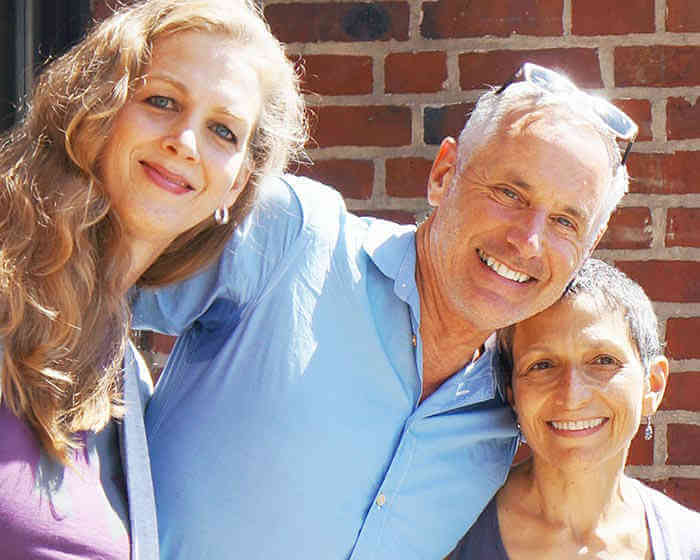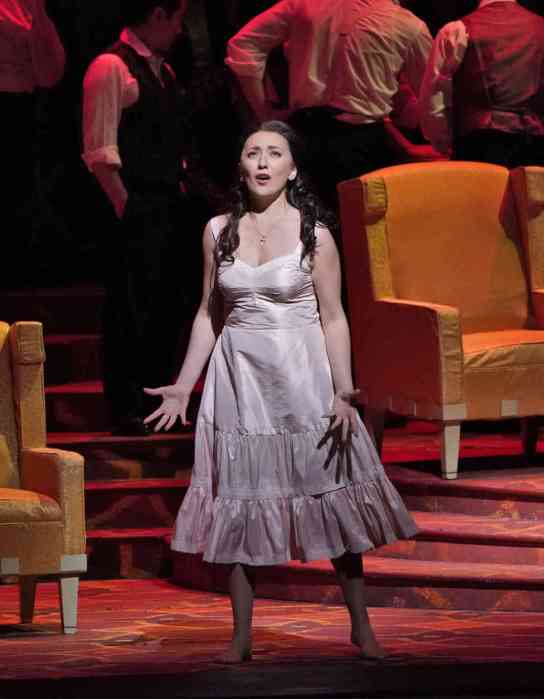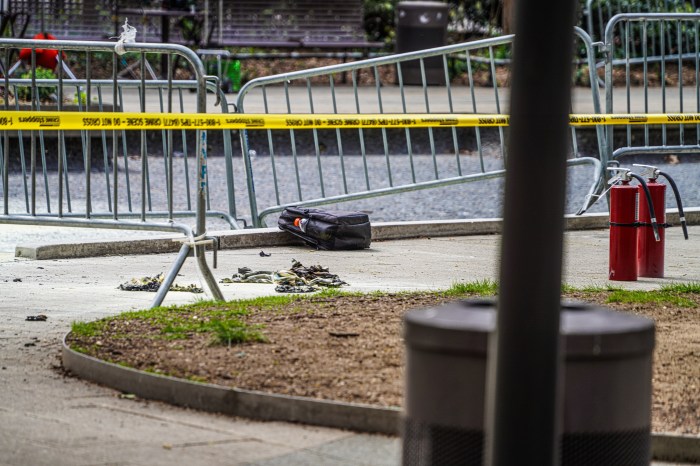Elizabeth Caballero in the title of Daniel Catán’s “Florencia en el Amazonas,” which had its New York premiere with the New York City Opera. | SARAH SCHATZ
BY ELI JACOBSON | The search for love is a central drive in life and art. Love can take us into unfamiliar places — both in the wilds of our imagination and physically beyond the safety of our homes. Two operas presented this summer explored that search.
New York City Opera followed up their rather uncertain inaugural production of “Tosca” with the New York premiere of Daniel Catán’s “Florencia en el Amazonas” — and it was a triumph. This was a New York City Opera that followed the mission of the original company — a contemporary opera cast showcasing talented young American and Hispanic singers in an inventively simple and imaginative production.
“Florencia,” which premiered in Houston in 1996, is inspired by the magical realism of Gabriel García Márquez with a Spanish-language libretto by his pupil Marcela Fuentes-Berain. The plot takes place circa 1910 and centers on the return of international prima donna Florencia Grimaldi to her native land to sing in the opera house in Manaus. She travels incognito on the steamboat the El Dorado along with several other passengers who are traveling to hear her sing — the young journalist Rosalba who is writing the enigmatic diva’s biography, the captain’s nephew Arcadio, and a bickering couple Paula and Alvaro who have buried their love in bitter recrimination. The captain of the ship is devoted to a life on the sea while the shipmate Riolobo is a supernatural intermediary between mankind and the mystical world of nature.
Women’s quests front and center in “Florencia en el Amazonas,” “Patience & Sarah”
Florencia is on a secret mission to find her long-lost love Cristóbal, who freed her magical voice but then disappeared into the Amazon jungle in search of the world’s rarest butterfly, the Emerald Monarch. The ship travels down the Amazon River encountering a storm and a cholera epidemic along the way. Florencia eventually realizes that her reunion with Cristóbal may only be possible in the world of the spirit, not on earth.
The neoromantic tonal score by the late Catán is as lush and varied as the Brazilian landscape it depicts. An amalgam of late Puccini, Villa-Lobos, with hints of Bernstein and Stravinsky, “Florencia” has its own distinctive personality and individual sound world. It may not strike new ground but is worthy of its predecessors — and the vocal writing is rewarding for the singers and the audience alike. Conductor Dean Williamson gave a transparency to the score. balancing lush lyricism with dramatic propulsion. The pick-up orchestra played with unfailing discipline and flawless ensemble.
The talented cast was led by soprano Elizabeth Caballero as Florencia. Caballero has that distinctive Spanish dark/ bright sound — a lush, deep velvet core with an overlay of shimmering silvery brilliance (Montserrat Caballé exemplifies this vocal type). Tenor Won Whi Choi sang with untiring bright tone in the upper range as the idealistic young Arcadio. Lyric soprano Sarah Beckham-Turner’s quick vibrato suggested the youth and hidden insecurity of the outwardly bold Rosalba. The rock solid alto-colored voice of Lisa Chavez created a stern but passionate Paula, while baritone Luis Ledesma was a virile Alvaro. Kevin Thompson’s smooth rich bass made the Captain a center of calm in the storm while Philip Cokorinos’ craggy bass suggested the ambiguous nature of Riolobo.
The production originally conceived and directed for Nashville Opera by John Hoomes, uses a simple platform downstage to represent the ship, with dancers below it in white bodysuits embodying the Amazon River that both gives and takes life. The world surrounding the ship was projected upstage behind the singers on a screen spanning the proscenium. Exotic vistas of tropical forests and water in saturated colors moved at a slightly slower pace than the stage action like the background of a waking dream. The shallow stage of the Rose Theater seemed to contain an entire world — or several worlds, supernatural and real.
Some production elements had a rather childlike naiveté: the dancers rolled around on the floor, looking like refugees from a science fiction ballet, but also represented the anthropomorphic nature of the Amazon interacting with the singers as the story demands. The final tableau had Florencia herself morphing into the Emerald Monarch butterfly and flying into the hands of a projected image of Cristóbal. The juvenile dream imagery was kitschy but congruent with the aesthetics of Latin American magical realism. Every element came together magically in this production, which demands to be seen again for a longer run.
While the Metropolitan Opera went dark, the New York Opera Fest brightened the New York opera scene, sponsoring a two-performance revival in late June of Paula Kimper’s pioneering 1998 lesbian folk opera “Patience & Sarah” just in time for the Gay Pride celebrations. Based on the true story of the early 19th century painter Mary Ann Willson, who lived with her companion Miss Brundage as a “farmerette” in upstate Greene County, “Patience & Sarah” is considered the first opera to portray the love of two self-affirming women.
Nadia Petrella and Elsa Quéron in the New York Opera Fest revival of Paula Kimper’s 1998 lesbian folk opera “Patience & Sarah.” | MARIA BARANOVA
The libretto by Wende Persons based on the novel by Isabel Miller (the nom de plume of Alma Routsong) is set in 1816 Connecticut, where the educated and wealthy painter Patience White encounters illiterate farm girl Sarah Dowling, who has been raised as a boy and dresses like one. Their forbidden love must overcome both social and religious disapproval and their different backgrounds. Unlike the star-crossed heterosexual lovers in opera whose forbidden love breaks the rules of society, these two women do not die tragically but leave their homes to go pioneering together on a farm in upstate New York.
In the intimate Players Theatre space, Kimper conducted the score in a new seven-piece orchestration for chamber and staged concert opera presentations. The original director, Douglas Moser, created a modest, bare bones production that cut straight to the heart of the matter with no fuss.
Interestingly the femme partner in the couple, Patience White (sung by the lovely Nadia Petrella with a darkly vibrant full lyric soprano), came off as the confidently proactive seducer of the baby butch Sarah Dowling. French mezzo-soprano Elsa Quéron as Sarah embodied a bright yearning spirit, younger in heart and mind than the more mature, socially poised Patience. Yet Sarah is surer of her feelings and recklessly brave in enduring the beatings of her father and the dangers of the road in her quest for true love.
As the wandering bookseller Parson Daniel Peel, who takes in the runaway Sarah and falls in love with her thinking she is a boy, baritone Michael Kelly charmed with a rich lyric baritone and open emotional vulnerability. Vivid supporting turns by soprano Bryn Holdsworth, mezzo Jessica Lauren Copland, tenor Chad Kranak, and bass Duncan Hartman brought the disapproving families of Patience and Sarah to life, avoiding clichés.
Kemper’s score has elements of Aaron Copland’s nostalgic Americana spiced with Straussian autumnal harmonies. The excellence of the vocal writing was evidenced by the fact that I could understand about 98 percent of the libretto without supertitles. The sensitively lyrical score reaches the heart.
The opera still runs a little long in the second act, where the travails of the central couple when they are parted go on too long. This revival, however, showed that “Patience & Sarah” is not nor has it ever been just a niche novelty piece for one targeted audience. It is a true American opera that embodies our spirit of freedom and personal destiny — going into the wilderness to discover ourselves and build a new and better world.



































